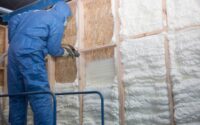Think about having to clean up a very dangerous mess. This could be cleaning up after something bad has happened, a sickness that spreads easily, or a big mess left by someone who collects too much stuff. This cleaning job is not just regular tidying up; it’s a very important task that needs to be done carefully. Cleaning up hazardous materials is necessary to make places safe to live in again. But do you know what safety steps experts take when they deal with these risky materials? In this article, we’re going to explain in a simple and easy-to-understand way the methods and safety rules that experts follow when cleaning up hazardous messes.
The Essentials of Safe Cleanup Processes
First off, what exactly is a biohazard? It’s anything biological that could potentially cause harm to humans or animals – think blood, bodily fluids, and microbial nasties like bacteria and viruses. Cleaning these up is more complex than donning rubber gloves and going at it with a mop. It’s a meticulous process involving a series of well-thought-out steps.
Personal Protective Equipment (PPE)
Our first line of defense in biohazard cleanup is what we wear. Personal Protective Equipment, commonly known as PPE, includes:
-
Heavy-duty gloves
-
Protective suits that block out contaminants
-
Respiratory masks to filter out dangerous particles
-
Eye protection in case of splashes or sprays
-
Proper footwear to prevent slips or punctures
Ensuring these items are worn correctly and discarded safely after use is crucial to protect the cleaning crew and prevent cross-contamination.
Assessing Biohazards
We have to know what we’re dealing with before we even touch a contaminated surface. This usually means identifying the types of biohazards present and understanding their risks. For instance, the approach to cleaning up bloodborne pathogens differs from dealing with chemical spills.
Containment and Control
Next up, we focus on containment. This means setting up physical barriers to keep the biohazards in one place and stop them from spreading. It’s about creating a zone that’s clearly marked as a no-go area for those not involved in the cleanup. Our team uses plastic sheeting and other barriers to seal off the area effectively.
Proper Disposal
Disposal is more complex than chucking things in the trash. Anything contaminated with a biohazard has to be treated like the potent threat it is. That means putting it in specially designed biohazard bags, which are extra sturdy and often red to signal the danger inside. Then, we’re talking about proper transport and incineration or specialized disposal to make sure those biohazards can’t harm anyone else.
Leveraging Technology and Techniques
It’s not just brute force and a strong stomach that get us through a biohazard cleanup. Specialized equipment and proven techniques are part of our repertoire, too.
Advanced Cleaning Agents
You can’t use everyday cleaning supplies for biohazard situations. We need the heavy artillery in terms of disinfectants and cleaning agents – things that are robust enough to annihilate bacteria and viruses on contact.
Technological Tools
Technology plays a role as well. For instance, we might use foggers to disperse antimicrobial substances throughout a room, ensuring every nook and cranny is treated. UV light is sometimes employed to kill pathogens that are hanging about in the air or on surfaces.
Regulated Waste Transport
When it comes time to get rid of the biohazard waste, we can’t just throw it in the back of any old truck. Regulations dictate that particular vehicles designed for transporting such materials must be used. These vehicles make sure the waste gets to its final destination without posing a risk to the public or the environment.
Documentation and Compliance
It’s not all physical work; there’s a stack of paperwork to boot. We have to document everything we do, both to meet government regulations and to provide peace of mind for our clients. Detailed records of the materials disposed of, the techniques used, and the cleaning agents employed must be kept.
Special Considerations for Unique Scenarios
Each biohazard scene is a unique beast, and some require extra-special attention.
Hoarding Situations
In hoarding scenarios, such as those needing hoarders cleaning services in biohazard incidents, we’re not just dealing with clutter. Often, there’s a mix of decaying waste, pests, and stagnant water, turning the scene into a hotbed for pathogens. Cleaning these places up requires a delicate balance between thorough biohazard removal and respecting the emotional challenges the owners face.
Cleanup After Infectious Disease Outbreak
An infectious disease outbreak can turn an everyday space into a biohazard zone pretty quickly. Cleaning up means not just eliminating the existing biohazards but also setting up measures to prevent a future outbreak. It’s an in-depth process that must cover all aspects of the affected area.
Industrial Accidents and Chemical Spills
When chemicals are spilled, it’s not just about the biological risks. We’re also dealing with potentially volatile substances that can cause burns or explosions. The cleanup process demands a measured approach that neutralizes the immediate dangers before any deep cleaning begins.
The Role of Professionals
Let’s be real – biohazard cleanup is no DIY project. It requires a specialized skill set, not to mention a strong constitution. That’s where professional cleanup crews come in.
A San Antonio restoration company, for instance, is equipped to tackle these hazardous situations head-on. These crews are trained professionals who know their way around the perils of biohazard cleanup. They are the unsung heroes who make our homes and workplaces safe after something’s gone horribly wrong.
Final Thoughts
To sum up, dealing with biohazardous materials requires a meticulous approach grounded in safety and science. It’s about donning the right gear, using the right tools, and adhering to strict protocols. Remember, these measures are as much about protecting the cleanup crew as they are about ensuring the safety of the general public. So, while it’s something we hope you’ll never need, it’s good to know that there’s a method to the madness in biohazard cleanup, and it’s carried out by professionals who truly care.







